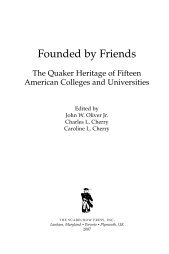Separate Realities: The Dream and the Iceberg - Scarecrow Press
Separate Realities: The Dream and the Iceberg - Scarecrow Press
Separate Realities: The Dream and the Iceberg - Scarecrow Press
You also want an ePaper? Increase the reach of your titles
YUMPU automatically turns print PDFs into web optimized ePapers that Google loves.
70 Chapter 2<br />
to those reported in a 1999 national survey, which found 55 percent of respondents<br />
expected children would be better off as adults than <strong>the</strong>ir parents. 137<br />
Perhaps consistent with many American workers’ pessimistic views regarding<br />
<strong>the</strong>ir prospects for achieving <strong>the</strong> American <strong>Dream</strong>, marriage rates <strong>and</strong> traditional<br />
family lifestyles have declined. In 1970, married couples with a child<br />
(or children under age eighteen) accounted for 50 percent of all U.S. families<br />
<strong>and</strong> 40 percent of all U.S. households. But in 2004, <strong>the</strong> proportion of traditional<br />
families (married couples with children under eighteen) had declined<br />
to 34 percent of all families <strong>and</strong> to 23 percent of all households. During <strong>the</strong><br />
same period, nonfamily households as a share of all households increased<br />
from 19 percent in 1970 to 32 percent in 2004. 138 While shifts in <strong>the</strong> age structure<br />
of <strong>the</strong> U.S. population may partially explain <strong>the</strong>se trends, <strong>the</strong>y may also<br />
be due, at least in part, to many workers’ shrinking income <strong>and</strong> benefit levels.<br />
For many, it is increasingly apparent that <strong>the</strong> financial security central to <strong>the</strong><br />
American <strong>Dream</strong> <strong>and</strong> <strong>the</strong> economic resources necessary to support traditional<br />
family lifestyles are drifting out of reach today.<br />
“<strong>The</strong> world is a vampire—set to drain [you],” sang Smashing Pumpkins, a<br />
popular alternative rock b<strong>and</strong> more than a decade ago. In <strong>the</strong> mid-2000s, <strong>the</strong><br />
singer Pink asked on her I’m Not Dead album how <strong>the</strong> president could sleep<br />
“while <strong>the</strong> rest of us cry?” Despite being a decade apart, <strong>the</strong>se two grim takes<br />
on <strong>the</strong> life chances of youth were not isolated musical messages. In fact,<br />
<strong>the</strong>mes of pessimism <strong>and</strong> cynicism were, <strong>and</strong> are, often woven into <strong>the</strong> lyrics<br />
of U.S. popular music. <strong>The</strong> content of many songs makes it clear that <strong>the</strong><br />
b<strong>and</strong>s—<strong>and</strong> <strong>the</strong>ir youthful audiences—know <strong>the</strong>y’re being used, <strong>and</strong> <strong>the</strong>y<br />
don’t like it. In <strong>the</strong> mid-2000s, some youthful audiences began to show <strong>the</strong>ir<br />
objection to <strong>the</strong>ir generally gloomy life chances (<strong>and</strong> to <strong>the</strong> Iraq war) by supporting<br />
(with <strong>the</strong>ir dollars) sales of “new protest” music aimed largely at <strong>the</strong><br />
Bush administration. Musicians from divergent genres, including Pink, Pearl<br />
Jam, Merle Haggard, Neil Young, Eminem, Green Day, Bruce Springsteen, <strong>and</strong><br />
Madonna, produced anti-Bush songs in <strong>the</strong> mid-2000s. 139 While popular support<br />
for a new wave of political protest songs is an interesting development,<br />
attacking—or even defeating—Bush <strong>the</strong> political leader doesn’t address or<br />
even begin to change <strong>the</strong> privileged-class-based policies that have produced<br />
<strong>and</strong> perpetuate <strong>the</strong> conditions that concern some youthful audiences. <strong>The</strong> reality<br />
is that few contemporary <strong>and</strong> popular, youth-oriented songwriters/b<strong>and</strong>s<br />
offer emancipatory visions or alternatives to youthful working-class audiences<br />
regarding how <strong>the</strong>y can counter, in meaningful ways, <strong>the</strong> sense that <strong>the</strong>ir future<br />
life chances are compromised by an increasingly unequal social order <strong>the</strong>y<br />
nei<strong>the</strong>r control nor underst<strong>and</strong>.<br />
With some exceptions, much contemporary popular music conjures up for<br />
today’s youth a bleak, iron-cage imagery of <strong>the</strong>ir world. Many young people<br />
appear to feel trapped in a predictable, downsized, dead-end society composed<br />
of institutions that ensnare ra<strong>the</strong>r than liberate <strong>the</strong>m, including school,<br />
work, <strong>the</strong> pop culture industry (which rationalizes <strong>and</strong> markets “cool” to kids
















